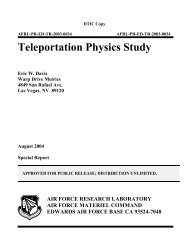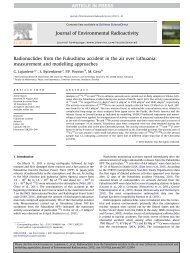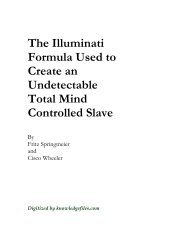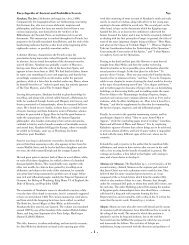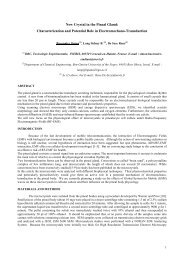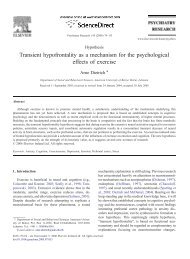Psychology of Terrorism - National Criminal Justice Reference Service
Psychology of Terrorism - National Criminal Justice Reference Service
Psychology of Terrorism - National Criminal Justice Reference Service
You also want an ePaper? Increase the reach of your titles
YUMPU automatically turns print PDFs into web optimized ePapers that Google loves.
one’s own group and towards others that stand in certain relationships to it).-Tajfel defines "social identity" to mean that part <strong>of</strong> an individual’s self concept that derives from hisor her knowledge <strong>of</strong> membership <strong>of</strong> a social group (or groups) together with the value and emotionalsignificance attached to that membership.-With in the context <strong>of</strong> social identity theory, stereotypes are reconceived as generalizations aboutpeople based on category membership.-Social identity theory itself is developing a sophisticated battery <strong>of</strong> ideas for resolving intergroupconflict. Three prominent areas (among many) are crossed categorizations (using one socialcategory to cancel out another), recategorization (bringing members <strong>of</strong> two categories togetherunder an inclusive, superordinate one), and decategorization (dissolving the problematic categoriesaltogether, especially by facilitating contact between members <strong>of</strong> rival groups).28. Brockner, J. , & Rubin, J. K. (1985). Entrapment in escalating conflicts: A social psychological analysis. NewYork: Springer-Verlag.Call Number: Editor's Annotation: This book is a technical treatise on how and why people continueto move forward on a decision they think is stupid or at least doomed to a bad outcome. The socialpsychologicalterm for being stuck is “entrapment.” The authors use the following formal definition<strong>of</strong> entrapment: "a decision making process whereby individuals escalate their commitment to apreviously chosen, though failing, course <strong>of</strong> action in order to justify or 'make good on' priorinvestments." Most <strong>of</strong> the book focuses on pure, experimental social psychological research, whichhas very little relevance to counterterrorism operations. In fact, there is no discussion <strong>of</strong> terrorism,per se, anywhere in the book. Although this text thoroughly analyzes the research on social andnonsocial factors that effect “entrapment,” it is highly questionable whether these results wouldtranslate into any meaningful understanding <strong>of</strong> terrorist groups. It is interesting to note, though, thatthey found no compelling or even promising evidence for “entrapment prone personality.” Perhaps<strong>of</strong> some interest are the findings in chapter seven describing psychological effects <strong>of</strong> entrapment,including the way in which it can alter motivations and lead to a lack <strong>of</strong> attention to any “outside” orperipheral factors. Chapters nine and ten ostensibly discuss some implications, but the applied valuefor counterterrorism is rather limited. In essence, the research would suggest that if one thinks aheadabout what could happen as a result <strong>of</strong> a decision and what the downsides or “costs” may be, thismay build some resistance to entrapment.29. Bruan De Dunayevich, J., & Puget, J. (1989). State <strong>Terrorism</strong> and Psychoanalysis. International Journal <strong>of</strong>Mental Health, 18(2 ), 98-112.Call Number: Editor's Annotation: Between 1976 and 1983, state terrorism produced a type <strong>of</strong>violence in Argentina with specific characteristic types that contained within it death, sophisticatedcruelty and terror.-Focuses on the victimization <strong>of</strong> victims <strong>of</strong> this oppressive state <strong>of</strong> violence.-Describes tactics <strong>of</strong> repression used by the regime.-A methodology <strong>of</strong> repression: Disappearance - Disappearance, employed as a method <strong>of</strong> ideologicalrepression, involving kidnapping, clandestine detention, and later murder <strong>of</strong> adults, adolescents, andchildren <strong>of</strong> a specific social-cultural and ideological background, who may or may not have beenpolitical militants.30. Bruce, S. (1990). Protestant resurgence and fundamentalism . Political Quarterly, 61, 161-168.Call Number: Editor's Annotation: In this brief essay I will describe three movements which aresometimes called 'fundamentalist': Pentecostalism in Latin America and other parts <strong>of</strong> the ThirdWorld, the new Christian right in American, and Paisleyism in Northern Ireland. After a briefaccount <strong>of</strong> each I will <strong>of</strong>fer some general and comparative observations about 'fundamentalism'.-There are undoubtedly political causes and consequences <strong>of</strong> the spread <strong>of</strong> Pentecostalism. Ratherthan seeing the spread <strong>of</strong> Pentecostalism as a sinister right-wing plot, one should appreciate theparallels between the social and psychological roles <strong>of</strong> Methodism in urban England in the secondhalf <strong>of</strong> the eighteenth century.-To take a positive side <strong>of</strong> appeal <strong>of</strong> Pentecostalism, it <strong>of</strong>fers to those people who are, as DavidMartin put it, outside the downward thrust <strong>of</strong> elite power and free from the lateral ties <strong>of</strong> the organiccommunity, a new character.



